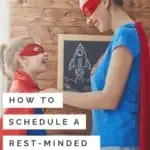Disclosure: This post may contain affiliate links, which means we may receive a commission if you click a link and purchase something that we have recommended. While clicking these links won’t cost you any extra money, they will help us keep this site up and running! Please read our disclaimer for more details. Thank you for your support!
Whether you take a relaxed approach to homeschool planning or you map out every day in advance, knowing what works best for your family is paramount. Here’s the approach we’re taking this year, inspired by Sarah Mackenzie’s Teaching From Rest.
Planning for a more restful year
As we set out on the seventh year of our homeschooling journey, I find myself taking a radically different approach to homeschool planning than I did in previous years.
Here’s my homeschool planning track record in a nutshell:
- Year 1: (two kids, ages three and five). No planning. Spent the whole year winging it, trying fun activities discovered on Pinterest or through the website of the school we’d registered with. Kept a daily journal recording our activities.
- Years 2-3: (still two kids). Discovered Cathy Duffy (homeschool curriculum guru). And learning styles. And teaching styles. Went crazy with curriculum. Bought everything. Finished it all (somehow). Didn’t really use a planner, just plugged away at every book, every day. Kept a daily journal.
- Years 4-5: (two kids homeschooling, plus a baby). Discovered Debra Bell, my homeschool hero. And her Ultimate Homeschool Planner. Got more intentional with my planning, but still bought way too much and scheduled way too much. Barely made it through.
- Year 6: (two kids homeschooling, one preschooler, one baby). Somehow did not learn my lesson. Made a fantastic schedule on my computer but still completely overestimated how much we could do (not just in terms of curriculum, but also with extra-curriculars). The schedule worked well, but it also opened my eyes to how unsustainable it was. We were exhausted and cranky all the time. Still, we scraped through on the promise that this year would be different.
Yes, I say that every year. But if you read this post, you know I’m for real this time.
It occurs to me now, as I look over this brief glimpse into the past six years, that each year was, in fact, different. It wasn’t perfect. It wasn’t necessarily better. But each was different in its own way. We have continually tried new things, innovated, discarded practices that weren’t working for us, learned from our mistakes. And if that’s not what homeschooling is about, I’m not sure what is.
So, all that to say: here is what we’re doing differently this year in our homeschool planning to have a more restful year.
Starting our homeschool planning with the vision for our homeschool
I came across this philosophy first in Deborah Bell’s Ultimate Guide to Homeschooling, and I’m embarrassed to admit that in all the years I’ve had the book I never really got around to it. I mean, I always had goals, but I’d never written down a long-term vision for our homeschool with my husband. I usually took the standard approach of researching everything I was “supposed to teach,” comparing dozens of available resources on each of these prescribed subjects, and purchasing way more than was ever helpful or appropriate.
And to what end? I have piles of finished workbooks, scrapbooks full of completed assignments, kids who know how to whip through a stack of unfinished projects in the last forty-eight hours before a tri-annual home visit. I have report cards showing just how much we took on in each of the past six years.
But is that why we are homeschooling? Is that really all we hope to gain from this massive endeavour, this labour of love? Because all of these things could just as easily be gained in school, probably better than I can teach them at home.
But there’s so much more to it than that. We long to pass on our faith, to have it become their own, not just an echo of their parents’.
We long to instill our family’s values, a deep love of Jesus and of each other, a desire to serve others. We want them to explore their gifts and talents and have the space and encouragement needed to pursue them. We want to give them the opportunity to question things, to make mistakes, to fail, to change their minds without judgment.
When my husband and I sat down to answer two important questions, these were just some of the things we came up with.
The first question, adapted from The Ultimate Guide to Homeschooling:
What would you like to have be true of your children when they are done homeschooling?
And the second, from Teaching From Rest:
How do you want your children to look back on their homeschooling years and remember you?
Answering these questions put everything into a new perspective for me. Suddenly all of those subjects I have to teach became a lot less important. Things like Bible study, character development, quality time as a family, margin for exploration and mistake-making, and inquiry-based learning started to feel weightier. How could my children learn to learn from their mistakes if they never had time to fail and try again? Over-scheduling was robbing us of the time we needed to devote to these fundamental pursuits of our homeschool.
Start with a vision and everything else will fall into place.
Cutting down on curriculum
I have a tendency to overdo things. If one novel study is recommended for grade three, surely ten is better? If a child wants to work harder to get a year ahead in her math, why not work even harder to get two years ahead? If I can’t find one program that handles reading comprehension, grammar, writing, and spelling in a way that works, there’s no reason why we can’t work on four different language arts books every day. Right?
I’m sure you’re shaking your head at me. Maybe you’ve been there too, or maybe you’ve always known better than that. Perhaps you had a wise mentor along the way who advised you to take it slow, to not try and cram so much in. In fact, I have such a mentor. But do you think I listened to her? Well, yes, I did listen. I listened and smiled and nodded and envied. I wished that I had her courage and trust, her ability to operate without a hard and fast plan, her ability to teach her children naturally as they went about their daily life, knowing that everything was going to be fine.
But I’m a list-maker, a box-checker. I even have a masters degree in logistics. Seriously. That’s a thing. I thought that I could apply the same efficiency and time management principles to homeschooling as I did to business and we’d have a recipe for success. But it was a disaster.
Why?
Because children are not businesses. The development of hearts and minds is not the same as the management of the bottom line.
We cannot forecast character development or schedule meetings with God. We cannot squeeze in an hour of question-asking and assume that we’ve cultivated their ability to explore. Truthfully, it’s hard enough to predict how long it will take to do a single math lesson or to write a story. How much more so the real work of homeschooling?
The only way to create an atmosphere conducive to this sort of learning and development is to build in some margin. To cut back enough that there is space and time for children’s minds and hearts to expand.
In our home, this meant nixing much of the curriculum and changing the way we approach the resources that we do choose to keep.
Selecting the Curriculum
Cutting back also meant that any curriculum we selected had to pass rigorous tests. It had to contribute to at least one (hopefully more) of the goals in our long-term homeschool vision. It had to be of the highest quality, extremely engaging, and suitable to both my kids’ learning styles and my teaching style.
I love programs that don’t require any planning on my part, but at the same time, we don’t like worksheets and busy work. We want the assignments to be meaningful, the books we read to etch themselves on our minds. We want math and science programs that teach to high standards while remaining accessible and enjoyable to high-energy learners.
In case you are curious, here are the resources we are using this year. It is a very short list (at least compared to what we’re used to), and for that I am thankful. It’s also the first year that both me and my kids are all excited about every item on the list. Win!
Bible study
This year we’re trying something new for Bible study. My friend Amy, founder of Take a Walk Ministries, has created a Bible study journal that can be used to do an in-depth study of any Bible passage. Her method involves reading the passage daily over several days and analyzing different aspects of it (language, context, history, cross-references, etc.) each day. My husband is developing a list of thirty scripture passages for us to study together as a family this year using this method. What I love about is that we are not beholden to somebody else’s list of chapters they think we should read. We can select any stories that we think are most relevant in our homeschool this year and apply this rigorous study method to each of them, making it a completely customizable program. Learn more about her method and workbook here.
Math
Math: After five years of Singapore Math, we’ve decided to go in a new direction. Not because Singapore Math isn’t excellent; it definitely is. However, we just learned about Beast Academy this year, and we are very excited to give it a try. Our girls are highly artistic and love anything artsy, so the fact that these books are presented as graphic novels was a huge selling feature for them. There are many excellent reviews online of Beast Academy, including this one.
English
Reading: We are continuing with Debra Bell’s Readers in Residence program this year. (Read my review here). It is an excellent reading comprehension program that has also had a huge impact on our children as aspiring writers.
Writing: This year we’re going to try Debra Bell’s Writers in Residence program as well. My kids are avid writers, but they struggle to complete the things they start. I’m hoping that the well developed structure of this program will help them with that. Like Readers in Residence, we’ll probable only aim to get through half of this program in the first year.
Also, my kids have started blogs through kidblog.org, a site that allows students around the world to easily publish their own blogs that can be shared privately or publicly. I’ll be assigning them fun writing assignments to complete on there as well.
Science
We started using Apologia’s amazing science program last year and are continuing on this year with Exploring Creation with Human Anatomy and Physiology. I adore these books and I regret not finding them sooner. The books are filled with tons of information presented in a remarkably clear and easy to follow manner. The notebooking journals are full of meaningful projects and activities and make for a one-of-a-kind keepsake at the end of the year. The Human Anatomy book is so dense that it will probably takes us a couple of years to get through it. We are planning to spend half the year on science and the other half on socials, something I have not tried before.
Socials
Last year we studied Canadian history to Confederation; this year we’re going from Confederation to present day. Last year we read over two dozen books for socials; this year I’m aiming for four to five very well written biographies in conjunction with the Canada: A People’s History DVDs.
Foreign languages
This year we are introducing basic Latin and Greek into our line-up, more for out of curiosity than anything. We’ll be using Latin for Children and Greek Alphabet Code Cracker. We’re using Duolingo for French.
Morning time and nature walks
New this year, we are adding morning times and nature walks to the schedule. I had never heard of the concept of morning time until I read Teaching from Rest, but now I’m so excited about it. Year after year, I have bought art and music resources that have sat untouched in favour of the “more academic subjects.” Now we actually have a space on our schedule dedicated to the enjoyment of art and nature. What a gift!
Weekly homeschool schedule
As I mentioned above, I’ve gone through many phases of homeschool planning over the past six years. I’ve run the gamut from no planning, to detailed daily plans and everything in between. I’ve also read many other blogs and books by homeschoolers describing their scheduling preferences and methods and why they work for them.
My conclusion?
No two homeschools are alike, and neither are homeschool plans. We all respond differently to different types of plans. Some people really thrive on knowing exactly what needs to be covered each day; for others, this is totally stressful. Some children are completely independent and can get all of their work done on their own, given a daily schedule. Others need a lot more guidance. What works for me may not work for you, but I will share it with you, in case you are frustrated with your current scheduling method or do not have one yet.
In my house, I find that everything takes a lot longer than I think it will. My kids all want a lot of attention and there are constant interruptions. When I schedule particular lessons or pages for each day and we don’t complete them, I get really stressed out. I’m not good at being behind, particularly in things over which I have little control.
Also, psychologically, I tend to minimize what we’ve accomplished if we didn’t do everything we set out to do, even if it was still quite a substantial amount.
For example, say we read ten books. If we originally set out to read ten books, we’re doing alright; if we set out to read five, we’re feeling like all-stars right now. But what if we set out to read twenty? Ten now feels like a huge failure, even though they’re the same ten books that felt great a minute ago.
Setting unrealistic goals can lead to feelings of failure and inadequacy, even when you’re actually doing quite well.
Instead, we schedule time slots. I set an hour aside four times a week for math, for example. We work as hard as we can for that hour, then we put it aside. Some days, we may finish half a page. Others, we may finish an entire lesson. It totally depends on the topic being covered and what kind of day we’re having. Either way, we can feel good knowing that we put in a solid hour.
I know that might sound scary. Approaching scheduling this way can mean that you may not finish the book by the end of the year. (We actually just finished our math books from last year a couple weeks ago). But it has virtually eliminated feelings of frustration, despair, and failure in our home because we always feel like we’re making progress, no matter how slow.
The other benefit of scheduling this way is that you don’t have to make a weekly plan. You make a weekly schedule once and repeat it every week until something changes (i.e. you add a new subject or finish something). This was so liberating for me last year and saved me a lot of time, energy, and paper.
Here’s a snapshot of our schedule for this year.

Sophie Agbonkhese is a writer, homeschooling mother of four, and a recovering overachiever (who occasionally relapses). She is the founder of My Cup Runs Over, a site dedicated to helping busy women simplify and enrich their lives. When she’s not writing or debugging websites, Sophie spends her time reading, dancing, bullet journaling, reading, gardening, listening to audiobooks, and striving fruitlessly to have a clean house for at least five minutes.



